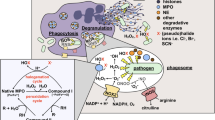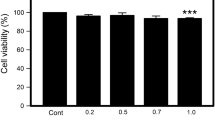Abstract
Zinc has been shown to disturb the innate host defense response by interfering in the activation of neutrophils and subsequent oxidative burst, although the exact role of this metal, either as an activator or inhibitor, remains a matter of controversy among research groups. These apparent discrepancies may be due to experimental settings, through modification of zinc availability to neutrophils, or to inaccurate detections of reactive species. Thus, the main objective of the present study was to provide clarification on the role of zinc on the activation of human neutrophils and the subsequent oxidative burst. For that purpose, different detection methods and incubation media were used. The obtained results showed that phosphate buffers (PBS and HBSS) complex with zinc and interfere with the results obtained with this metal. By using Tris-G, it was clearly demonstrated that zinc, at low concentrations (5–12.5 μM), activates NADPH oxidase, mainly via protein kinase C, leading to the formation of superoxide radical (O2 •−). Higher concentrations of zinc results on a rapid dismutation of O2 •− to oxygen and hydrogen peroxide, which in turn is used by myeloperoxidase to generate hypochlorous acid (HOCl).






Similar content being viewed by others
Abbreviations
- PMN:
-
Polymorphonuclear leukocytes
- ROS:
-
Reactive oxygen species
- RNS:
-
Reactive nitrogen species
- PKC:
-
Protein kinase C
- ABAH:
-
4-Aminobenzoyl hydrazide
- PMA:
-
Phorbol myristate acetate
- PBS:
-
Dulbecco’s phosphate buffer saline
- HBSS:
-
Hank’s balanced salt solution
- Tris-G:
-
Tris buffer saline
- APF:
-
6-(4′-Amino)phenoxy-3H-xanthen-3-on-9-yl]benzoic acid
- HRP:
-
Horseradish peroxidase
- Amplex Red:
-
10-Acetyl-3,7-dihydroxyphenoxazine
- DPI:
-
Diphenyleneiodonium chloride
- Gö6983:
-
3-[1-[3-(Dimethylamino)propyl]-5-methoxy-1H-indol-3-yl]-4-(1H-indol-3-yl)-1H-pyrrole-2,5-dione
References
Ahluwalia J, Tinker A, Clapp LH, Duchen MR, Abramov AY, Pope S, Nobles M, Segal AW (2004) The large-conductance Ca2+-activated K+ channel is essential for innate immunity. Nature 427:853–858
Babior BM (1999) NADPH oxidase: an update. Blood 93:1464–1476
Benoni G, Cuzzolin L, Marrella M, Crivellente F, Adami A, Bertaso C, Velo G, Milanino R (1998) Neutrophil behavior following exposure to in vivo or in vitro zinc in normal and acutely-inflamed rats: studies on lysozyme secretion, superoxide anion release and platelet adhesion. Inflammation 22:175–189
Beyersmann D, Haase H (2001) Functions of zinc in signalling, proliferation and differentiation of mammalian cells. Biometals 14:331–341
Brunelli SM, Goldfarb S (2007) Hypophosphatemia: clinical consequences and management. J Am Soc Nephrol 18:1999–2003
Collier HB (1979) Binding of Zn2+ by buffers. Clin Chem 25:495–496
Costa D, Gomes A, Lima JL, Fernandes E (2008) Singlet oxygen scavenging activity of non-steroidal anti-inflammatory drugs. Redox Rep 13:153–160
Cross AR, Segal AW (2004) The NADPH oxidase of professional phagocytes–prototype of the NOX electron transport chain systems. Biochem Biophys Acta 1657:1–22
Csermely P, Szamel M, Resch K, Somogyi J (1988) Zinc can increase the activity of protein kinase C and contributes to its binding to plasma membranes in T lymphocytes. J Biol Chem 263:6487–6490
Dawson EB, Evans DR, Harris WA, Powell LC (2000) Seminal plasma trace metal levels in industrial workers. Biol Trace Elem Res 74:97–105
DeCoursey TE, Morgan D, Cherny VV (2003) The voltage dependence of NADPH oxidase reveals why phagocytes need proton channels. Nature 422:531–534
Dekker LV, Leitges M, Altschuler G, Mistry N, McDermott A, Roes J, Segal AW (2000) Protein kinase C-beta contributes to NADPH oxidase activation in neutrophils. Biochem J 347:285–289
Denicola A, Radi R (2005) Peroxynitrite and drug-dependent toxicity. Toxicology 208:273–288
Essin K, Salanova B, Kettritz R, Sausbier M, Luft FC, Kraus D, Bohn E, Autenrieth IB, Peschel A, Ruth P, Gollasch M (2007) Large-conductance calcium-activated potassium channel activity is absent in human and mouse neutrophils and is not required for innate immunity. Am J Physiol Cell Physiol 293:C45–C54
Femling JK, Cherny VV, Morgan D, Rada B, Davis AP, Czirjak G, Enyedi P, England SK, Moreland JG, Ligeti E, Nauseef WM, DeCoursey TE (2006) The antibacterial activity of human neutrophils and eosinophils requires proton channels but not BK channels. J Gen Physiol 127:659–672
Fosmire GJ (1990) Zinc toxicity. Am J Clin Nutr 51:225–227
Frasco MF, Fournier D, Carvalho F, Guilhermino L (2005) Do metals inhibit acetylcholinesterase (AChE)? Implementation of assay conditions for the use of AChE activity as a biomarker of metal toxicity. Biomarkers 10:360–375
Freitas M, Porto G, Lima JL, Fernandes E (2008) Isolation and activation of human neutrophils in vitro. The importance of the anticoagulant used during blood collection. Clin Biochem 41:570–575
Freitas M, Lima JL, Fernandes E (2009a) Optical probes for detection and quantification of neutrophils’ oxidative burst. A review. Anal Chim Acta 649:8–23
Freitas M, Porto G, Lima JL, Fernandes E (2009b) Optimization of experimental settings for the analysis of human neutrophils oxidative burst in vitro. Talanta 78:1476–1483
Hampton MB, Kettle AJ, Winterbourn CC (1998) Inside the neutrophil phagosome: oxidants, myeloperoxidase, and bacterial killing. Blood 92:3007–3017
Hasegawa H, Suzuki K, Nakaji S, Sugawara K (2000) Effects of zinc on the reactive oxygen species generating capacity of human neutrophils and on the serum opsonic activity in vitro. Luminescence 15:321–327
Henderson LM, Chappell JB, Jones OT (1988) Superoxide generation by the electrogenic NADPH oxidase of human neutrophils is limited by the movement of a compensating charge. Biochem J 255:285–290
Irato P, Albergoni V (2005) Interaction between copper and zinc in metal accumulation in rats with particular reference to the synthesis of induced-metallothionein. Chem Biol Interact 155:155–164
Kauppinen TM, Higashi Y, Suh SW, Escartin C, Nagasawa K, Swanson RA (2008) Zinc triggers microglial activation. J Neurosci 28:5827–5835
Lindahl M, Leanderson P, Tagesson C (1998) Novel aspect on metal fume fever: zinc stimulates oxygen radical formation in human neutrophils. Hum Exp Toxicol 17:105–110
Maret W, Sandstead HH (2006) Zinc requirements and the risks and benefits of zinc supplementation. J Trace Elem Med Biol 20:3–18
Miyamoto S, Ronsein GE, Prado FM, Uemi M, Correa TC, Toma IN, Bertolucci A, Oliveira MC, Motta FD, Medeiros MH, Mascio PD (2007) Biological hydroperoxides and singlet molecular oxygen generation. IUBMB Life 59:322–331
Mladenka P, Simunek T, Hubl M, Hrdina R (2006) The role of reactive oxygen and nitrogen species in cellular iron metabolism. Free Rad Res 40:263–272
Muzyka V, Bogovski S, Viitak A, Veidebaum T (2002) Alterations of heme metabolism in lymphocytes and metal content in blood plasma as markers of diesel fuels effects on human organism. Sci Total Environ 286:73–81
Noh KM, Koh JY (2000) Induction and activation by zinc of NADPH oxidase in cultured cortical neurons and astrocytes. J Neurosci 20:RC111
Parkin G (2004) Synthetic analogues relevant to the structure and function of zinc enzymes. Chem Rev 104:699–767
Remijsen QF, Fontayne A, Verdonck F, Clynen E, Schoofs L, Willems J (2006) The antimicrobial peptide parabutoporin competes with p47(phox) as a PKC-substrate and inhibits NADPH oxidase in human neutrophils. FEBS Lett 580:6206–6210
Rink L, Gabriel P (2001) Extracellular and immunological actions of zinc. Biometals 14:367–383
Stefanidou M, Maravelias C, Dona A, Spiliopoulou C (2006) Zinc: a multipurpose trace element. Arch Toxicol 80:1–9
Suh SW, Hamby AM, Gum ET, Shin BS, Won SJ, Sheline CT, Chan PH, Swanson RA (2008) Sequential release of nitric oxide, zinc, and superoxide in hypoglycemic neuronal death. J Cereb Blood Flow Metab 28:1697–1706
Takeyama Y, Ogino K, Segawa H, Kobayashi H, Uda T, Houbara T (1995) Effects of zinc on production of active oxygen species by rat neutrophils. Pharmacol Toxicol 76:50–55
Witko-Sarsat V, Rieu P, Descamps-Latscha B, Lesavre P, Halbwachs-Mecarelli L (2000) Neutrophils: molecules, functions and pathophysiological aspects. Lab Invest 80:617–653
Zhang XG (1996) Corrosion and electrochemistry of zinc. Plenum Press, New York
Acknowledgments
Marisa Freitas acknowledges Fundação para a Ciência e Tecnologia (FCT) and Fundo Social Europeu (FSE) her PhD grant (SFRH/BD/28502/2006).
Author information
Authors and Affiliations
Corresponding author
Rights and permissions
About this article
Cite this article
Freitas, M., Porto, G., Lima, J.L.F.C. et al. Zinc activates neutrophils’ oxidative burst. Biometals 23, 31–41 (2010). https://doi.org/10.1007/s10534-009-9264-x
Received:
Accepted:
Published:
Issue Date:
DOI: https://doi.org/10.1007/s10534-009-9264-x




